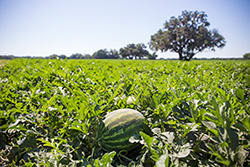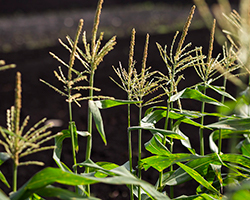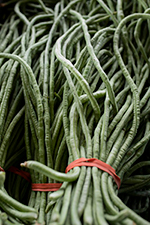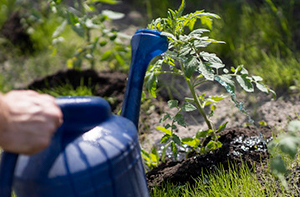
Illustration by Anna Juchnowicz
Three Sisters for Florida
Corn, beans, and squash are called the "three sisters," a winning combination discovered by Mesoamericans thousands of years ago. The corn provides support for climbing beans, the beans fertilize the soil for the corn, and the squash leaves suppress weeds. Best of all, gardeners build zero trellises and pull very few weeds.
If you'd like to mix a little history in with your gardening, who not give the Three Sisters a try using Florida-Friendly varieties?
The Three Sisters Intercropping Model
The three sisters are more than a piece of history; they're an ingenious model for intercropping. In the traditional combination, corn, beans, and squash each play an important role:
- Trellis — The first "sister" in the trio acts as a trellis, supporting a climbing bean. Traditionally corn is chosen for its tall, strong stalks. There aren't many better edible options in Florida so we suggest sticking with the original for this role. Florida gardeners can choose between sweet corn, popping corn, or even an ornamental variety.
- Fertilizer — The second sister is generally a climbing bean. Legumes, like the traditional pole bean, fix nitrogen in the soil. This helps fertilize the soil and keep up with the heavy nitrogen demands of a tall grass, like corn.
In Florida, there are dozens of climbing bean varieties to choose from. 'McCaslan', 'Kentucky Wonder', 'Rattlesnake', and 'Blue Lake' are good pole bean varieties for Florida gardens. Other species of climbing beans include long and yard-long beans, winged beans, and some varieties of broad bean. - Weed Management — The third and final sister is a low-growing vegetable with big, wide, sun- blocking leaves. When little or no sunlight makes it to ground level, weed growth is suppressed and your free time can be spent showing off your garden instead!
This role offers perhaps the largest variety of vegetables to choose from. Any warm-season vegetable that fits the description above, and can be planted about a month after corn, will do. Summer or winter squash are the traditional choices. You could also consider more heat-tolerant vegetables, like calabaza, or even a melon, like watermelon. But skip climbing gourds, like Seminole pumpkin; corn stalks aren't strong enough to support such heavy fruits.

The wide leaves of melons and squashes suppress weeds by blocking sunlight. Credit: UF/IFAS
Planting the Sisters
Spacing is particularly important in intercropping methods. Plant your crops too far apart and there will be room for weeds. Plant them too closely and you'll be battling mildews and have no space to walk. Don't be afraid to see your first year of intercropping as an experiment.

Corn is wind pollinated. Planting too few stalks in a stand may reduce your harvest. Credit: UF/IFAS
Sister #1: Plant the corn first, following the directions for your chosen variety. In North Florida, corn is generally planted between February and April. In Central Florida, plant between January and April. In South Florida you have the longest planting window of all: between October and March.
Perhaps the most difficult part of successfully growing the three sisters is establishing a vigorous stand of corn with only 7-10 stalks. Begin with well-tilled, fertile soil in a site that receives full sun. Corn is requires a lot of nitrogen. If you know your soil to be low on nitrogen, amend with compost or strong vegetable-gardening fertilizer.
Keep in mind: corn is wind pollinated. If you plant too little corn, your yields may suffer. You may want to 2-3 kernels per hole on your mounds. You can thin them to one plant every 8 inches once they germinate. For best results, plant corn in the arrangements of small hills traditional to the three sisters. Form raised mounds of soil a few feet wide, with room for 7-10 stalks of corn at the center and beans planted around the edges. The third sister is usually planted in the space between mounds or on its own mound, if it's a spreading variety.
Sister #2: Once the corn is about 6-12 inches tall, it's time to add climbing beans to the planting. First, weed the area thoroughly. Bean plants have weak root systems and once you've sown your beans, you'll need to avoid weeding nearby and disturbing the roots. This is also why most beans must be sown directly into the soil instead of transplanted.

Yard-long beans. Credit: UF/IFAS
Sow climbing bean seeds at the edge of the mounds, about 3-5 inches from the base of your young corn plants. For pole beans, sow seed about 1 inch into the soil and about 3–5 inches apart. For other bean varieties, follow the grower's planting instructions.
Sister #3: About a week after you plant your beans (around the time they start germinating) it's time to add the final sister to the planting.
The sprawling form and large leaves of squashes and melons mean that you don't need to plant directly next to your existing plantings for them to manage the weeds. Indeed, some models of the three sisters have pumpkins planted only every 7th mound. Though traditional, pumpkins may not be the best choice for your area. Follow the plant spacing instructions specific to your chosen crop.
Sister #4? Sometimes pollinator-attracting plants are added to this intercropping system as well. Pollinator plants like sunflowers, gaillardia, and salvia can be planted as a fourth sister, bordering the rows. They aren't necessary, but these blooms attract bees and other pollinators. If you've had trouble with fruit-set in squashes before, adding extra flowers to attract pollinators may be a good choice.
Care and Harvest
Intensive agriculture systems like the three sisters usually require frequent irrigation. If a daily watering schedule feels like too much, install a garden irrigation system before you sow the corn. Water your plants in the morning, giving the foliage time to dry before dark. Be sure to water so that the soil is moist to about 6 inches deep, as light sprinklings of water will encourage shallow rooting in corn. Of course, if rain is in the forecast or if the ground is still soaked from yesterday's downpour, you can skip the watering for a day or so.

Young corn plants are particularly vulnerable to insect damage. Scout your plantings frequently and dust with Bt (Bacillus thuringiensis) as a biological control if you spot caterpillars.
If your plants begin to yellow, an application of balanced, slow-release fertilizer may be necessary. A soil test can help you decide how to amend your soil before you begin.
At harvest time, harvest each crop as it ripens. Ideally the corn will ripen first, followed by the beans, and lastly the squash. But depending on your choices of species and varieties you may have to harvest a little at a time or out of order. Always leave the corn stalks standing until the beans are harvested, even if you've already harvested the ears of corn.
For more question about vegetable gardening or crops best suited to your area, please contact your county Extension office.
Also on Gardening Solutions
- Pole Beans
- Selecting Vegetables
- Starting From Seed
- Summer Squash
- Sweet Corn
- Vegetable Gardening in Florida
- Watering the Vegetable Garden
- Winter Squash

